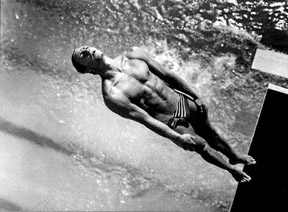I first begin this project in the
summer of 1995. The Atlanta Olympics were a year, away, and I knew I would
be covering them for Contact and Time Magazine, as I had for the previous
three Summer Games. As someone who was not really a sports photographer,
I had become more and more interested over that dozen years, in trying to
find new ways to capture the miracle of sport.
Technology, our now constant companion,
had blessed us each year with new and exciting tools. Now no event was too
far away, or too dimly lit be captured by the willing photographer. Lenses
became longer and faster (and heavier!), films faster and finer grained,
and even as access has tended to become more restricted, the best sports
photographers were getting closer and closer to that magic moment. That
moment when the action, the tension, the feel, and the body, all come together
to give the viewer an immediate look at what is really going on. Much of
what was being done, good as it was, had a kind of "in your face"
feel to it. Because the ability to get closer was there, everyone was taking
advantage of it.
I started looking back at what had been
done in the early decades of this century in sports photography to see if
there was a lesson to be learned. Looking at what the best photographers
from other eras have done is often instructive and inspirational. The tools
they had were so rudimentary compared to what we have today, that they had
to rely on their vision and ingenuity to make great pictures. (Can you imagine
the groaning that would take place if you asked a newspaper photographer
to go on a job now with a Speed Graphic and a holder with two sheets of
film?) What I saw was something so old that perhaps it was new again. Context.
A sense of Place.
I realized that much of what bothered me
about contemporary sports photography was that in an attempt to bring the
viewer ever closer, it often omitted the context of where, and how the event
was taking place. I consciously decided to shoot in medium format, something
which would yield a finer, larger negative, and permit large prints to be
made with ease. I must say that the transition to medium/large format for
someone who has spent a life in 35mm is a challenging one. But rather quickly
I become very comfortable with the Mamiya 645 and Mamiya 6 cameras. They
have certain 35mm-style quality in their ease of handling. One of the main
challenges, however, is that with the larger cameras, you have only one
shot. One try. One picture.
As in the days of the Speed Graphic, you
load your film, wait, and then shoot. And clearly, the waiting and watching
is the key. You know you have only one try, and your skills start to return.
The sense of discipline, the patience to wait, and capture The Moment. Sometimes
you get it, as in all photography, and most often you don't . But the exercise
was very invigorating. I felt as if I had rediscovered a way of seeing that
had been lost. Shooting with shorter lenses, I purposefully included more
of the background, and this sense of place is a very strong element to the
pictures.
My friend and Raymond Depardon, at the 1992
Winter Olympics in Albertville, France had decided to propose to the city
leaders a project related to the games there. Hundreds of photographers
from all over the world would descend on Albertville for two weeks, each
bringing long lenses, and warm weather gear. For those two weeks they would
shoot picture after picture of the skiers, skaters, and other athletes going
for the action pictures which we all saw in our newspapers and magazines.
But, in looking back at those pictures, who would ever know it had been
Albertville? It could have been anywhere. The skiers taken close up on the
slopes, the skaters, shot tightly as they spun, the jumpers, framed as they
left the ramp; none of them would be in a context to show the sense of what
the city itself looked like during the Games. Raymond shot for those two
weeks using a 8x10" camera, and his results are a view of the city
which, its safe to say, almost no other photographer bothered to stop and
look at.
In that way, I hoped to take some pictures
which might give a hint of the sport, but in a way which takes you there
to see and feel it. It was a wonderful project for me. Trying to see Sport,
or any other subject, in away you haven't traditionally done is always stimulating
and exciting. I hope this sense of excitment is something the viewer can
share.
David Burnett, April 1997.
[Technical information: film: Kodak Tri-x. Cameras:
Mamiya 645, Mamiya 7, Mamiya 6 lenses 45mm wide angle, 75/80 mm normal,
150 mm telephoto.]
David Burnett can be reached at: DavidB383@AOL.com
Contact Press Images 116 E. 27th St. 8th floor New York,
NY 10016. (212) 481-6910 |


